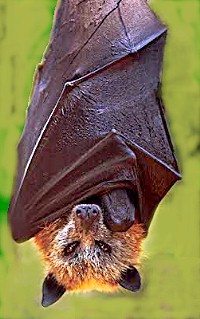Gold crowned flying fox
| Gold crowned flying fox | ||||||||||||
|---|---|---|---|---|---|---|---|---|---|---|---|---|

Golden-crowned fruit bat ( Acerodon jubatus ) |
||||||||||||
| Systematics | ||||||||||||
|
||||||||||||
| Scientific name | ||||||||||||
| Acerodon jubatus | ||||||||||||
| ( Eschscholtz , 1831) |
The giant golden-crowned flying fox ( Acerodon jubatus ) is a mammal of the family of flying foxes (Pteropodidae). It is considered to be one of the largest living bats .
features
Gold crowned fruit bats reach a head body length of up to 29 centimeters, a tail is missing as with almost all fruit bats. The wingspan is 1.5 to 1.7 meters and the weight of adult animals varies between 0.7 and 1.2 kilograms. (Whether it really is the largest bat is controversial; similar dimensions are known of the kalong and the Indian giant bat .)
In physique it corresponds to the other flying foxes, the flight membrane is stretched by the extended second to fifth fingers and reaches to the ankles. The snout is elongated and "dog-like", but the ears are small. The fur is dark in color, the name-giving feature is the orange-yellow colored head and neck area, the shoulders can also be yellowish.
distribution and habitat
These fruit bats are endemic to the Philippines , where they are found throughout the archipelago with the exception of the region around the island of Palawan . Their habitat are rainforests and mangrove areas from sea level to 1,100 meters above sea level.
Way of life
Golden crowned flying foxes, like most bats, are nocturnal. To sleep, they usually hang on trees in large colonies, often on small, offshore islands. From the 1930s there are reports of colonies comprising 150,000 animals; the groups are now much smaller due to the endangerment of the species.
In the evening they go in search of food, and they can often cover long distances - also across the sea. The diet of these animals consists of fruits, preferably figs .
Little is known about the reproduction of these animals. Once a year - usually in May or June - the female gives birth to a single young. Sexual maturity occurs at the age of two.
Danger
The golden crowned flying fox is an endangered species. The reasons for this are, on the one hand, the progressive destruction of its habitat and, on the other hand, hunting for its meat. In many regions of the Philippines the populations have decreased drastically, in some places the species has completely disappeared. Larger populations of the gold crowned flying fox live in the Northern Sierra Madre Natural Park , Hamiguitan and Mount Kalatungan Range Natural Park , among others . The IUCN lists the species as endangered .
literature
- Ronald M. Nowak: Mammals of the World. Johns Hopkins University Press, Baltimore 1999, ISBN 0-8018-5789-9
Web links
- Acerodon jubatus in the endangered Red List species the IUCN 2006. Posted by: Chiroptera Specialist Group, 1996. Retrieved on 21 8th of 2007.